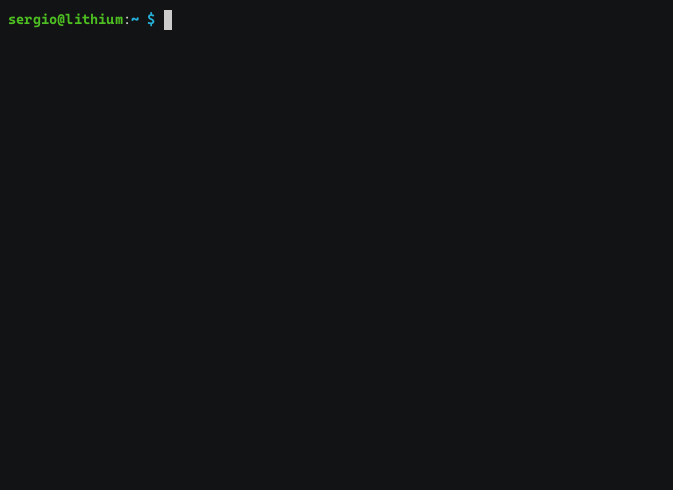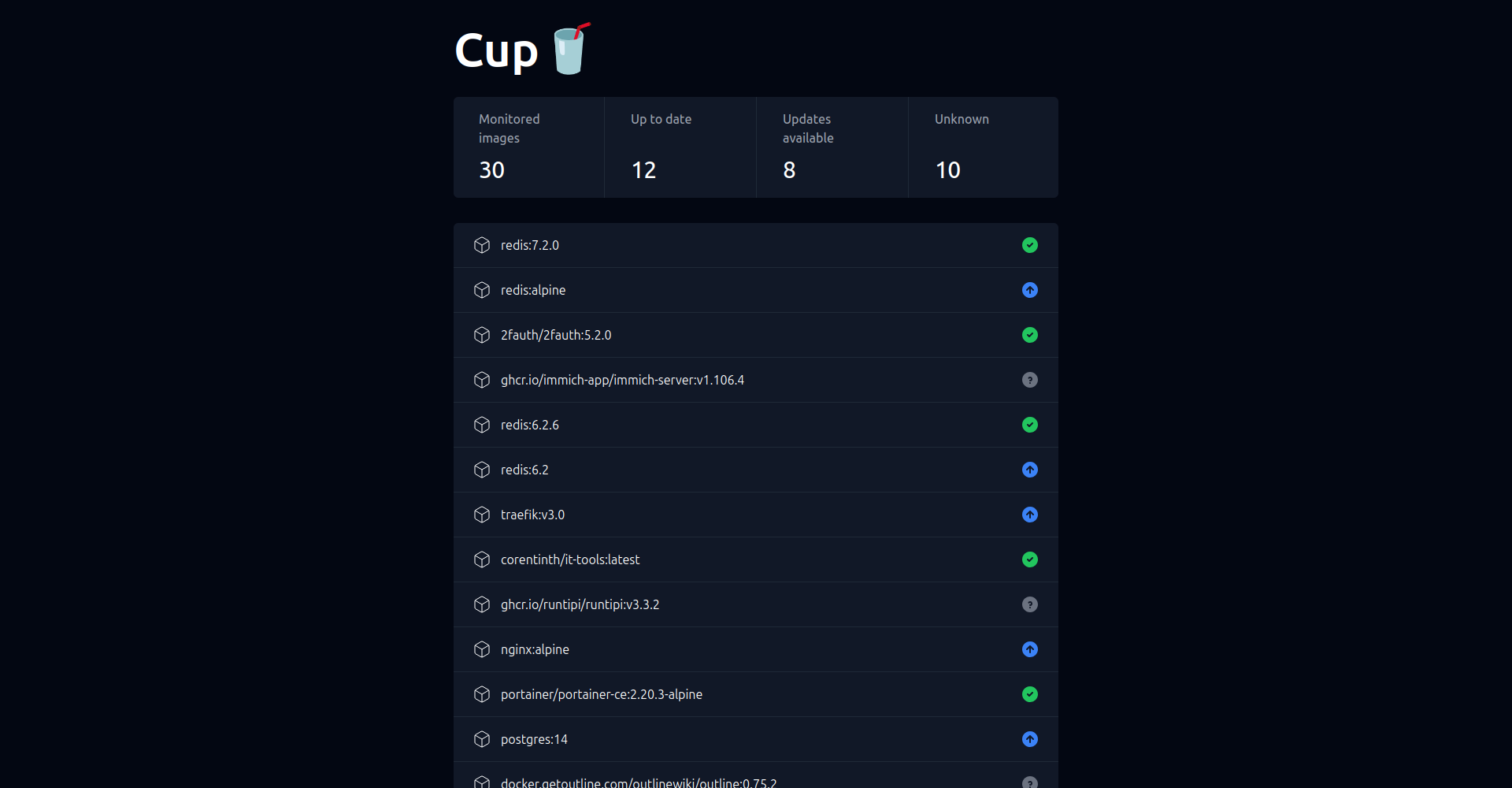About
Cup is a small utility that checks for updates to Docker containers. The logic is simple: Cup checks the locally pulled images' digests against the latest ones in their registry. It then presents the results in a pretty interface. Here's the story:
How it started
I got the basic idea for Cup a long time ago. I was looking at Homepage's list of widgets (opens in a new tab) when I discovered What's Up Docker? (opens in a new tab) (referred to as WUD from now on).
According to the docs:
What's up Docker ( aka WUD ) gets you notified when a new version of your Docker Container is available.
It supports the most common registries, has integrations with IFTTT, Slack, Telegram and other apps/services for notifications or triggering workflows and also has the option to automatically update containers, like Watchtower (opens in a new tab).
I was managing my homelab myself at that time and the only way to check if I had updates was log in to the server and manually try to pull the images for every single compose file. WUD seemed to solve the problem nicely, so I decided to give it a try. I never used automatic updates or notifications, but I configured it and let it run.
After deploying it and setting up my reverse proxy, I was greeted with this dashboard:

It was working fine, but... the UI was not what I expected. It really reminds me of some really old Android app (I hope I didn't offend anyone). That was strike one. Nevertheless, I left it running. It was useful after all.
A few days later I was pulling some docker images, when I got this error message:
You have reached your pull rate limit. You may increase the limit by authenticating and upgrading: https://www.docker.com/increase-rate-limits (opens in a new tab).
Wait a minute. What was that? I'd never encountered a message like this before. I thought "Weird. Maybe I pulled too many images today?". So I decided to finish those updates another day.
Next time I tried, same issue. "What the heck is happening?" I thought. The only change I'd made to my homelab at that time was installing WUD. So I stopped it. And that's where the problems ended.
The problem was clearly related to WUD, so I started trying to find what was going wrong. That was when I came upon this page from Docker's documentation (opens in a new tab). I noticed 2 things:
A pull request is defined as up to two
GETrequests on registry manifest URLs (/v2/*/manifests/*)
HEADrequests aren't counted.
There were also helpful instructions on how to check the rate limit:
sergio@desktop:~ $ TOKEN=$(curl "https://auth.docker.io/token?service=registry.docker.io&scope=repository:ratelimitpreview/test:pull" | jq -r .token)
% Total % Received % Xferd Average Speed Time Time Time Current
Dload Upload Total Spent Left Speed
100 5429 0 5429 0 0 7431 0 --:--:-- --:--:-- --:--:-- 7426
sergio@desktop:~ $ curl --head -H "Authorization: Bearer $TOKEN" https://registry-1.docker.io/v2/ratelimitpreview/test/manifests/latest
HTTP/1.1 200 OK
content-length: 2782
content-type: application/vnd.docker.distribution.manifest.v1+prettyjws
docker-content-digest: sha256:767a3815c34823b355bed31760d5fa3daca0aec2ce15b217c9cd83229e0e2020
docker-distribution-api-version: registry/2.0
etag: "sha256:767a3815c34823b355bed31760d5fa3daca0aec2ce15b217c9cd83229e0e2020"
date: Tue, 16 Jul 2024 12:13:17 GMT
strict-transport-security: max-age=31536000
ratelimit-limit: 100;w=21600
ratelimit-remaining: 100;w=21600
docker-ratelimit-source: <REDACTED>The rate limit is there, just like in the docs, but do you see something else interesting? Look at this header: docker-content-digest: sha256:767a3815c34823b355bed31760d5fa3daca0aec2ce15b217c9cd83229e0e2020
This is an image's digest. Can we check for updates by making HEAD requests to Docker Hub?
The answer is yes:
$ set TOKEN $(curl -H "Accept: application/vnd.docker.distribution.manifest.list.v2+json" "https://auth.docker.io/token?service=registry.docker.io&scope=repository:library/busybox:pull" | jq -r .token)
$ curl --head -H "Authorization: Bearer $TOKEN" -H "Accept: application/vnd.docker.distribution.manifest.v2.list+json" https://registry-1.docker.io/v2/library/busybox/manifests/latest
HTTP/1.1 200 OK
content-length: 6761
content-type: application/vnd.oci.image.index.v1+json
docker-content-digest: sha256:9ae97d36d26566ff84e8893c64a6dc4fe8ca6d1144bf5b87b2b85a32def253c7
docker-distribution-api-version: registry/2.0
etag: "sha256:9ae97d36d26566ff84e8893c64a6dc4fe8ca6d1144bf5b87b2b85a32def253c7"
date: Tue, 16 Jul 2024 12:17:49 GMT
strict-transport-security: max-age=31536000
ratelimit-limit: 100;w=21600
ratelimit-remaining: 100;w=21600
docker-ratelimit-source: <REDACTED>And then we can compare that with the digest of the image stored locally:
$ docker inspect busybox:latest | jq -r '.[0].RepoDigests[0]'
busybox@sha256:9ae97d36d26566ff84e8893c64a6dc4fe8ca6d1144bf5b87b2b85a32def253c7Notice how the 2 digests are the same. We can check for image updates without using up the rate limit!
That's when I got the idea of writing a program to do this automatically.
The birth of Cup
I initially intended to write a simple bash script but I chose not to for the following reasons:
- I wanted something more than a simple script. WUD has a web UI and support for so many integrations! I had to match that some way!
- Bash is slow and I was learning Rust at the time, so I wanted to practice (and make a proper project)
It started out as a small CLI that could either check a single image, or check all the images.

It also couldn't check for updates to images not from Docker Hub, lacked a web UI and generally had many limitations. But it proved it could be done, quickly and efficiently. The binary was just 5 MB and took about 5 seconds for ~90 images on my development machine. That's insane!
A few days later, I decided to completely rewrite it. I tried to write clean code, split it in files and fix every limitation from the previous version. I'm quite close. Here's what it looks like now:

It also has a statically rendered web UI making it ideal for self hosting.

With some optimization (well ok, maybe a lot), the binary is 5 MB and that means I finally don't have to wait forever to pull the Docker image! Finally something that works nicely with my 1.5 MB/s internet connection! (Thank you powerline!)
Now go ahead and try it out!